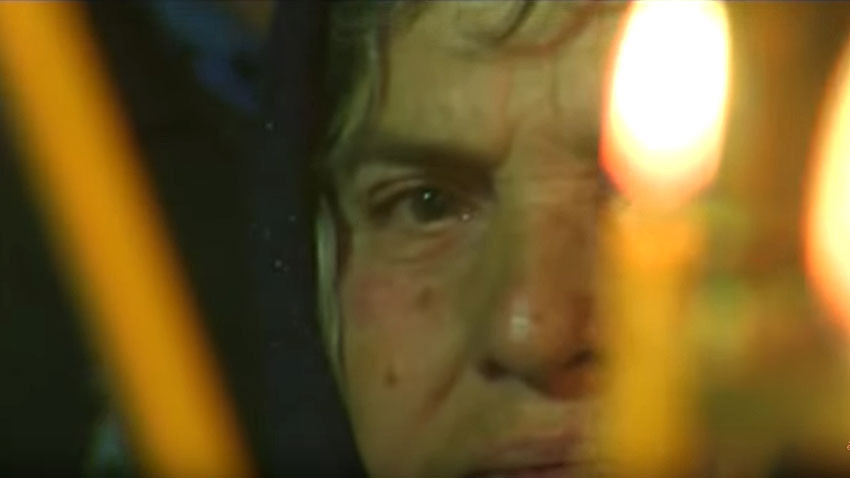Feet stepping heavily on the ground, sticking to a haunting rhythm of gripping melodies. Around the fire, men and women holding hands perform a chain dance and the dead are dancing along with the living. On the second day of Christ’s Resurrection.
Since time immemorial, the residents of several villages in the region of Vidin in North-western Bulgaria – Boinitsa, Gamzovo, Gradets and Rabrovo - perform the so-called “pomenalno horo” - chain dance of the dead in order to pay homage to all people who passed away since the previous Easter and also to get closer to the spirits of their beloved departed. They gather in the vicinity of the medieval rock monastery in the Albotin locality to perform a ritual chain dance, harbouring a belief that each person who made it to the world beyond should be given a dance.
“This is a ritual performed in the so-called “Golden Horn” near the town of Vidin – these are the villages along the Danube River where people make a procession carrying the portraits of their deceased relatives who passed away in the past year”, explains journalist and film director Stefan Dzhambazov who, along with his son David, filmed a documentary entitled “The Chain Dance of the Dead”. “This is the time of year when people perform slow chain dances and the relatives of the deceased bring eggs, clothes, food and wine as gifts to their fellow villagers. But they commemorate their dead without shedding any tears as they believe that the departed are also present right there on the feast day and that it is a time when the world of the living and the world of the dead get connected in one. They even place the photos of the dead on the windows of their houses so they could be able to look outside”.

These traditional chain dances commemorating the dead can be traced back to ancient practices and are typically performed with very slow steps in a counter clockwise direction. According to legend, they originated with the Thracian tribes who inhabited Bulgarian lands in Antiquity and who used to bury their dead with songs and merriment and were probably the first to create the custom of “handing out” a dance. Because, it turns out, since time immemorial people would imagine their afterlife as resembling their earthly existence. “This tradition is prevalent mostly in villages in Wallachia as the Vlachs are well-known for their deep veneration of the otherworld. They do not perceive a clear-cut boundary between the two worlds”, ethnographer Desislava Bozhidarova explains in the documentary.
It is no accident that the Vlachs call themselves “Romanized Thracians” and that’s why they also believe in the afterlife and bury their dead with their most valuable possessions, including a TV set sometimes. Some of them perform the ritual while still alive – they invite their relatives to a festive table, the priest utters a blessing, and everyone eats and drinks, except for the main hero. Others would erect their burial stone while still alive.
Unfortunately, this ritual is gradually disappearing because the local authorities show no support for it, the Vidin region gets more and more depopulated and people seem to care less and less about such rituals, Stefan Dzhambazov explains. Once, this tradition was very much alive and many large families would make their reunions at the Albotin monastery close to the fountain there. On the first day of Easter they would perform the ritual in their own villages, and on the second day they would gather to “hand out” the dances, as the event turned into a real feast. In recent year, however, the traditional chain dances for the dead get replaced by amateur performances that have nothing to do with the long-standing traditions. This is how we see the vanishing of this link between life and death, between the present and past worlds, between the sky and earth – this ancient, philosophical, pagan yet Christianity-related tradition, which claims that on Easter the dead and the living reunite and walk the same path.
Albeit neglect and negativity are erasing the last surviving vestiges of those traditions inherited from our ancestors, as long as there is at least one living witness treading the earth of the Vidin region, the tradition will survive: “In our region it’s like we live more for the sake of the dead, we commemorate them on each holiday. And instead of being joyful because it is now Easter and Christ is risen, we perform a special dance for the dead. We act the opposite way, we go to the village square to dance and mourn.”
English Rossitsa Petcova
Photos: archiveThe Bulgarian village of Turia at the southern foothill of the Balkan Range is welcoming over a thousand participants in the Masquerade Games "Old Men in Turia". This year's edition of the festival on 30 March will feature 28 mummers' groups from all..
"In a vast region in northern Bulgaria, St. Todor is somehow perceived as a demonic character... He visited gatherings of unmarried girls, which were prohibited during that period; he acquired the appearance of a young bachelor, but distinguishable by..
Thousands of cowbells of different sizes and shapes filled the streets of Yambol with chiming, jingling and ringing at the 25th International Masquerade Festival "Kukerlandia". Згдшд More than two thousand mummers - called kukeri, sourvakari,..

+359 2 9336 661
